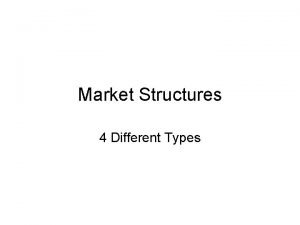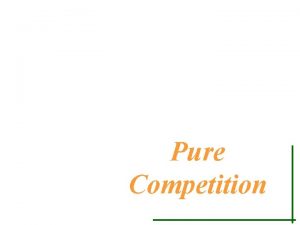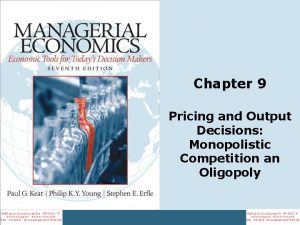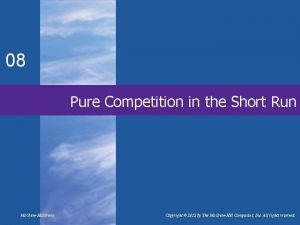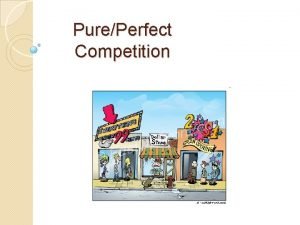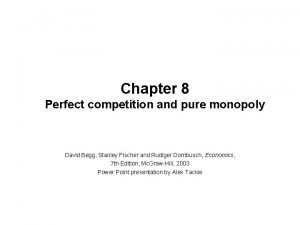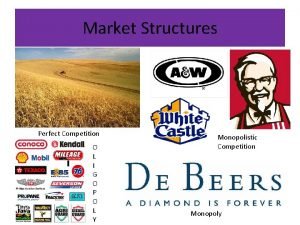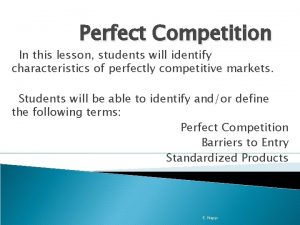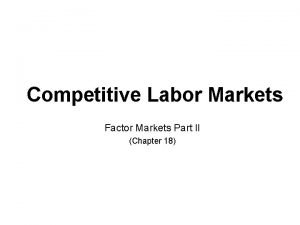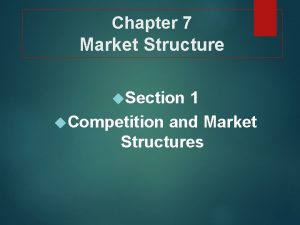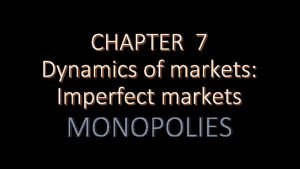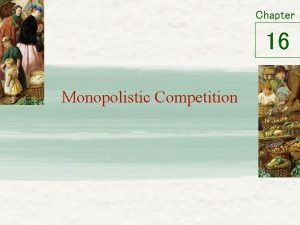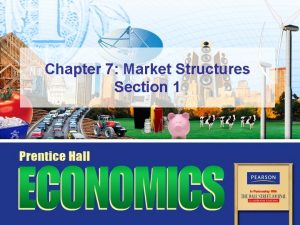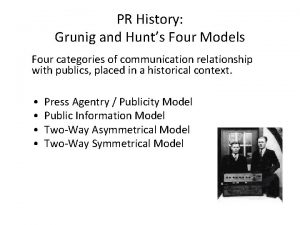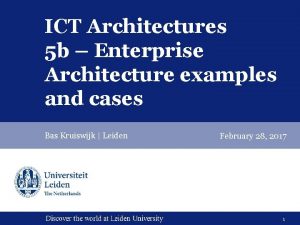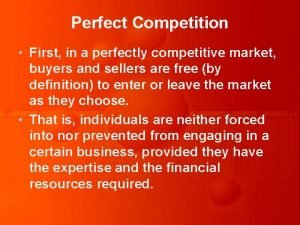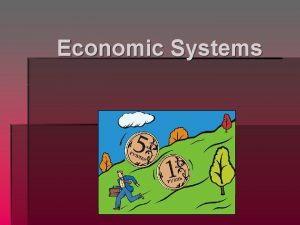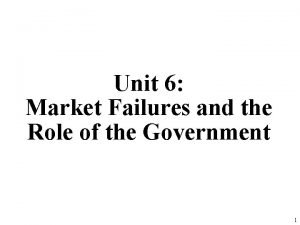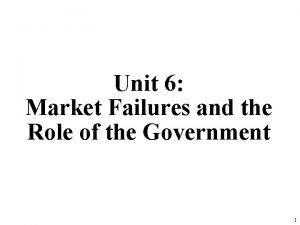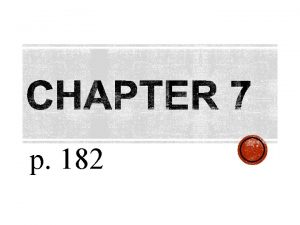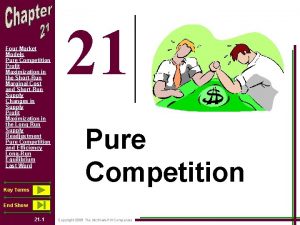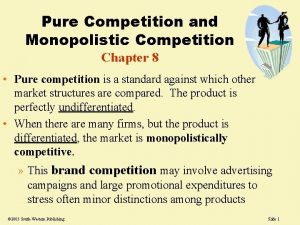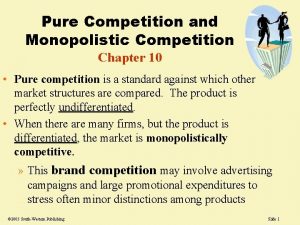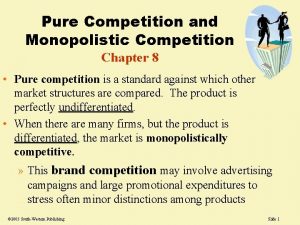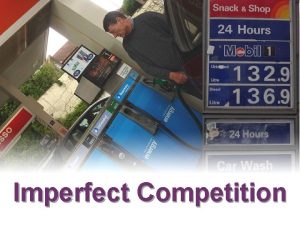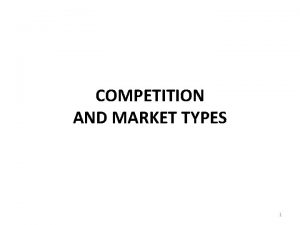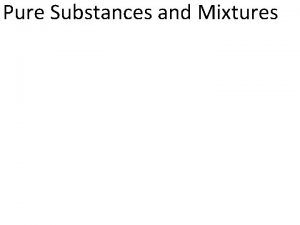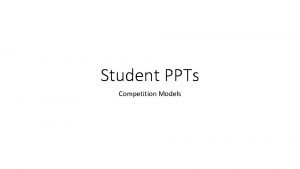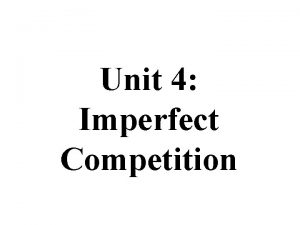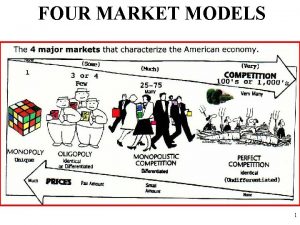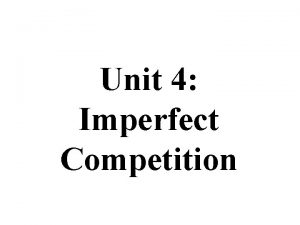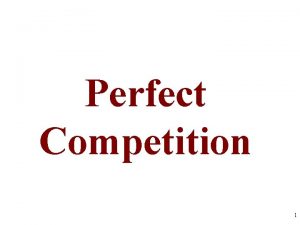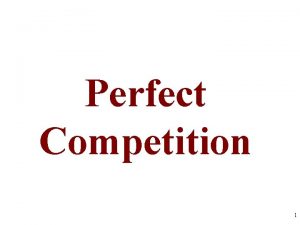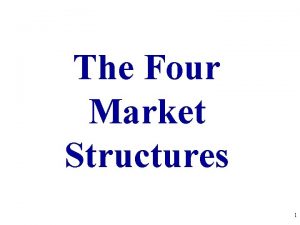6 LECTURE Pure Competition FOUR MARKET MODELS Pure







































- Slides: 39

6 LECTURE Pure Competition

FOUR MARKET MODELS Pure Competition Market Structure Continuum

FOUR MARKET MODELS Pure Monopoly Pure Competition Market Structure Continuum

FOUR MARKET MODELS Imperfect Competition Pure Monopoly Market Structure Continuum

FOUR MARKET MODELS Monopolistic Competition Pure Monopoly Market Structure Continuum

FOUR MARKET MODELS Oligopoly Pure Competition Monopolistic Competition Pure Monopoly Market Structure Continuum

FOUR MARKET MODELS Pure Competition: • Very Large Numbers • Standardized Product • “Price Takers” • Free Entry and Exit Pure Competition Monopolistic Competition Oligopoly Pure Monopoly Market Structure Continuum

DEMAND AS SEEN BY A PURELY COMPETITIVE SELLER Perfectly Elastic Demand Price Taker Role Total Revenue Average Revenue Marginal Revenue For example. . .

DEMAND AS SEEN BY A PURELY COMPETITIVE SELLER Product Price (P) Quantity Total (Average Revenue) Demanded (Q) Revenue (TR) $131 131 131 0 1 2 3 4 5 6 7 8 9 10 $ 0 ] 131 ] 262 ] 393 ] 524 ] 655 ] 786 ] 917 ] 1048 ] 1179 ] 1310 Marginal Revenue (MR) $131 131 131

DEMAND AS SEEN BY A PURELY COMPETITIVE SELLER Product Price (P) Quantity Total (Average Revenue) Demanded (Q) Revenue (TR) $131 131 131 0 1 2 3 4 5 6 7 8 9 10 $ 0 ] 131 ] 262 ] 393 ] 524 ] 655 ] 786 ] 917 ] 1048 ] 1179 ] 1310 Graphically Presented… Marginal Revenue (MR) $131 131 131

DEMAND, MARGINAL REVENUE, AND TOTAL REVENUE IN PURE COMPETITION TR 1179 Price and revenue 1048 917 786 655 524 393 262 D = MR 131 0 1 2 3 4 5 6 7 8 Quantity Demanded (sold) 9 10

SHORT RUN PROFIT MAXIMIZATION Two Approaches. . . First: Total-Revenue -Total Cost Approach The Decision Process: • Should the firm produce? • What quantity should be produced? • What profit or loss will be realized? The Decision Rule: Produce in the short-run if it can realize 1 - A profit (or) 2 - A loss less than its fixed costs

SHORT RUN PROFIT MAXIMIZATION Two Approaches. . . First: Total-Revenue -Total Cost Approach The Decision Process: • Should the firm produce? • What quantity should be produced? • What profit or loss will be realized? The Decision Rule: Produce in the short-run if it can realize 1 - A profit (or) 2 - A loss less than its fixed costs Applied Graphically…

TOTAL REVENUE-TOTAL COST APPROACH Total Price: $131 Variable Total Fixed Total e h n? Cost Revenue. Profit t Cost Product e o e ati s u 0 i$z 100 $ 100 o m y i x 100 n a 1 90 190 a C tm 2 100 170 270 i f o r 100 3 240 340 p 4 5 6 7 8 9 10 100 100 370 450 540 650 780 930 400 470 550 640 750 880 1030 $ 0 131 262 393 524 655 786 917 1048 1179 1310 - $100 - 59 -8 + 53 + 124 + 185 + 236 + 277 + 298 + 299 + 280

TOTAL REVENUE-TOTAL COST APPROACH Total Price: $131 Variable Total Fixed Total l a t Cost Product To e Cost Revenue. Profit u g n n e i $ 100 0 v h e p 1 R 100 a 90 190 r & G st 2 100 170 270 o C 100 3 240 340 4 5 6 7 8 9 10 100 100 370 450 540 650 780 930 400 470 550 640 750 880 1030 $ 0 131 262 393 524 655 786 917 1048 1179 1310 - $100 - 59 -8 + 53 + 124 + 185 + 236 + 277 + 298 + 299 + 280

Total revenue and total cost TOTAL REVENUE-TOTAL COST APPROACH $1, 800 1, 700 1, 600 1, 500 1, 400 1, 300 1, 200 1, 100 1, 000 900 800 700 600 500 400 300 200 100 0 Break-Even Point (Normal Profit) Total Revenue Maximum Economic Profits $299 Total Cost Break-Even Point (Normal Profit) 1 2 3 4 5 6 7 8 9 10 11 12 13 14

SHORT RUN PROFIT MAXIMIZATION Two Approaches. . . First: Total-Revenue -Total Cost Approach Second: Marginal-Revenue -Marginal Cost Approach MR = MC Rule Three Characteristics: • The rule applies only if producing is preferred to shutting down • Rule applies to all markets • Rule can be restated P=MC

MARGINAL REVENUE-MARGINAL COST APPROACH Average Price = Total Fixed Variable Total. Marginal Economic Product. Cost. Revenue Profit/Loss The same profit maximizing result! 0 - $100 1 $100. 00 $90. 00 $190. 00 90 $ 131 - 59 2 50. 00 85. 00 135. 00 80 131 -8 3 33. 33 80. 00 113. 33 70 131 + 53 4 25. 00 75. 00 100. 00 60 131 + 124 5 20. 00 74. 00 94. 00 70 131 + 185 6 16. 67 75. 00 91. 67 80 131 + 236 7 14. 29 77. 14 91. 43 90 131 + 277 8 12. 50 81. 25 93. 75 110 131 + 298 9 11. 11 86. 67 97. 78 130 131 + 299 10 10. 00 93. 00 103. 00 150 131 + 280

MARGINAL REVENUE-MARGINAL COST APPROACH Average Price = Total Fixed Variable Total. Marginal Economic Product. Cost. Revenue Profit/Loss 0 - $100 1 $100. 00 $90. 00 $190. 00 90 $ 131 - 59 2 50. 00 85. 00 135. 00 80 131 -8 3 33. 33 80. 00 113. 33 70 131 + 53 4 25. 00 75. 00 100. 00 60 131 + 124 5 20. 00 74. 00 94. 00 70 131 + 185 6 16. 67 75. 00 91. 67 80 131 + 236 7 14. 29 77. 14 91. 43 90 131 + 277 8 12. 50 81. 25 93. 75 110 131 + 298 9 11. 11 86. 67 97. 78 130 131 + 299 10 10. 00 93. 00 103. 00 150 131 + 280 Graphically

MARGINAL REVENUE-MARGINAL COST APPROACH Profit Maximization Position Cost and Revenue $200 Economic Profit MC 150 MR ATC AVC $131. 00 100 $97. 78 50 0 1 2 3 4 5 6 7 8 9 10

MARGINAL REVENUE-MARGINAL COST APPROACH Profit Maximization Position Cost and Revenue $200 Economic Profit MC 150 $131. 00 MR = MC 100 $97. 78 Optimum Solution 50 0 1 2 3 4 5 6 7 8 9 10 MR ATC AVC

MARGINAL REVENUE-MARGINAL COST APPROACH Loss Minimization Position If the price is lowered from $131 to $81 The MR=MC rule still applies …But the MR = MC point changes

MARGINAL REVENUE-MARGINAL COST APPROACH Loss Minimization Position Cost and Revenue $200 Economic Loss MC 150 ATC AVC MR 100 $91. 67 $81. 00 50 0 1 2 3 4 5 6 7 8 9 10

MARGINAL REVENUE-MARGINAL COST APPROACH Short-Run Shut Down Point Cost and Revenue $200 MC 150 ATC AVC 100 $71. 00 50 0 MR Minimum AVC is the Shut-Down Point 1 2 3 4 5 6 7 8 9 10

MARGINAL REVENUE-MARGINAL COST APPROACH Marginal Cost & Short-Run Supply Observe the impact upon profitability as price is changed Price Quantity Supplied Maximum Profit (+) Or Minimum Loss (-) $151 131 111 91 81 71 61 10 9 8 7 6 0 0 $+480 +299 +138 -3 -64 -100

MARGINAL REVENUE-MARGINAL COST APPROACH Cost and Revenue, (dollars) Marginal Cost & Short-Run Supply MC MR 5 P 5 ATC MR 4 P 4 AVC MR 3 MR 2 MR 1 P 3 P 2 P 1 Do not Produce – Below AVC Q 2 Q 3 Q 4 Q 5 Quantity Supplied

MARGINAL REVENUE-MARGINAL COST APPROACH Cost and Revenue, (dollars) Marginal Cost & Short-Run Supply P 5 Yields the Short-Run Supply Curve Supply MC MR 5 P 4 MR 4 P 3 MR 2 MR 1 P 2 P 1 No Production Below AVC Q 2 Q 3 Q 4 Q 5 Quantity Supplied

MARGINAL REVENUE-MARGINAL COST APPROACH Cost and Revenue, (dollars) Marginal Cost & Short-Run Supply MC 2 S 2 MC 1 S 1 AVC 2 AVC 1 Higher Costs Move the Supply Curve to the Left Quantity Supplied

MARGINAL REVENUE-MARGINAL COST APPROACH Cost and Revenue, (dollars) Marginal Cost & Short-Run Supply Lower Costs Move the Supply Curve to the Right MC 1 S 1 MC 2 S 2 AVC 1 AVC 2 Quantity Supplied

SHORT RUN COMPETITIVE EQUILIBRIUM The Competitive Firm “Takes” it’s Price from the Industry Equilibrium P Economic ATC Profit S=MC D $111 P S= MC’s $111 AVC D Firm 8 (price taker) Q 8000 Industry Q

SHORT RUN COMPETITIVE EQUILIBRIUM The Competitive Firm “Takes” it’s Price from the Industry Equilibrium P $111 Economic ATC Profit S=MC S= MC’s P How about the D long-run? AVC $111 D Firm 8 (price taker) Q 8000 Industry Q

PROFIT MAXIMIZATION IN THE LONG-RUN Goal. . . Price = Minimum ATC Zero Economic Profit Model

PROFIT MAXIMIZATION IN THE LONG-RUN Temporary Profits and the Reestablishment Of Long-Run Equilibrium P S 1 P MC ATC $60 50 40 MR D 1 100 Firm (price taker) Q 100, 000 Industry Q

PROFIT MAXIMIZATION IN THE LONG-RUN An increase in demand increases profits… P Economic Profits ATC S 1 P MC $60 50 40 MR D 2 D 1 100 Firm (price taker) Q 100, 000 Industry Q

PROFIT MAXIMIZATION IN THE LONG-RUN New Competitors increase supply and lower Prices decrease economic profits P Zero Economic Profits S 1 P S 2 MC ATC $60 50 40 MR D 2 D 1 100 Firm (price taker) Q 100, 000 Industry Q

PROFIT MAXIMIZATION IN THE LONG-RUN Decreases in demand, Losses and the Reestablishment of Long-Run Equilibrium P S 1 P MC ATC $60 MR $60 50 50 40 40 D 1 100 Firm (price taker) Q 100, 000 Industry Q

PROFIT MAXIMIZATION IN THE LONG-RUN A decrease in demand creates losses… P Economic Losses ATC S 1 P MC $60 MR $60 50 50 40 40 D 1 D 2 100 Firm (price taker) Q 100, 000 Industry Q

PROFIT MAXIMIZATION IN THE LONG-RUN Competitors with losses decrease supply and prices return to zero economic profits S 3 Return to Zero P Economic Profits S 1 P MC ATC $60 MR $60 50 50 40 40 D 1 D 2 100 Firm (price taker) Q 100, 000 Industry Q

LONG-RUN EQUILIBRIUM FOR A COMPETITIVE FIRM Price MC ATC MR P Price = MC = Minimum ATC (normal profit) Q Quantity
 Pure competition vs monopolistic competition venn diagram
Pure competition vs monopolistic competition venn diagram Pure competition market
Pure competition market Pure competition market
Pure competition market Market structures graphic organizer
Market structures graphic organizer Four market models
Four market models Characteristic of monopoly
Characteristic of monopoly Perfect competition vs monopolistic competition
Perfect competition vs monopolistic competition Competition refers to
Competition refers to 01:640:244 lecture notes - lecture 15: plat, idah, farad
01:640:244 lecture notes - lecture 15: plat, idah, farad Market leader challenger follower nicher examples
Market leader challenger follower nicher examples Objectives of segmentation
Objectives of segmentation Perfect/pure competition definition
Perfect/pure competition definition Difference between monopoly and monopolistic competition
Difference between monopoly and monopolistic competition A purely competitive seller is
A purely competitive seller is Pure competition
Pure competition The labor demand curve of a purely competitive seller
The labor demand curve of a purely competitive seller Characteristics of pure competition
Characteristics of pure competition Characteristics of pure competition
Characteristics of pure competition Oligopoly vs monopoly examples
Oligopoly vs monopoly examples Pure competition and monopoly _____
Pure competition and monopoly _____ Is milk a perfectly competitive market
Is milk a perfectly competitive market What is modals and semi modals
What is modals and semi modals Factor market perfect competition
Factor market perfect competition Lesson quiz 7-1 market structures
Lesson quiz 7-1 market structures Difference perfect competition and monopoly
Difference perfect competition and monopoly Difference between perfect competition and monopoly market
Difference between perfect competition and monopoly market How does deregulation encourage competition in a market
How does deregulation encourage competition in a market Grunig hunt
Grunig hunt Ict architecture example
Ict architecture example Stages of clinical supervision
Stages of clinical supervision The hunkins model
The hunkins model The four models of corporate entrepreneurship
The four models of corporate entrepreneurship Pure competitive market
Pure competitive market Which statement best describes a pure market economy?
Which statement best describes a pure market economy? What is a side of a shape
What is a side of a shape Skin assessment charting
Skin assessment charting Enumerate the market forms of meat in any order
Enumerate the market forms of meat in any order Customer driving marketing
Customer driving marketing Unit 6 market failures and the role of the government
Unit 6 market failures and the role of the government Unit 6 four market failures
Unit 6 four market failures


